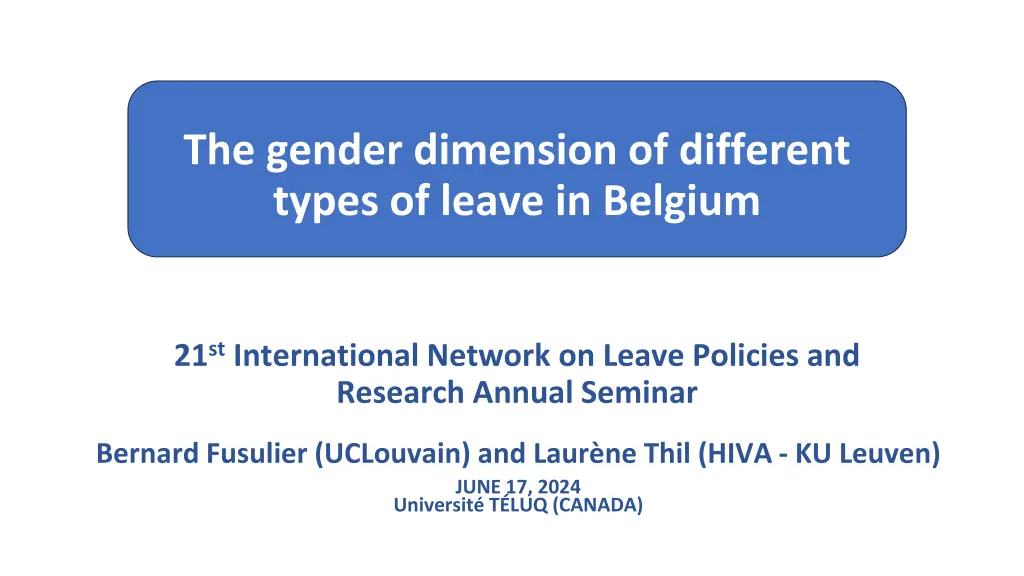
Exploring Gender Dimensions of Leave Policies in Belgium
Delve into the gender dimensions of various types of leave in Belgium, including parental leave, time credit, and career breaks. Learn about the report commissioned by the Belgian Institute for Equality between Women and Men, presenting methodology, data analysis, and main results. Discover key insights on parental leave duration, allowances, and regional differences. Gain valuable insights from this comprehensive research study.
Download Presentation

Please find below an Image/Link to download the presentation.
The content on the website is provided AS IS for your information and personal use only. It may not be sold, licensed, or shared on other websites without obtaining consent from the author. If you encounter any issues during the download, it is possible that the publisher has removed the file from their server.
You are allowed to download the files provided on this website for personal or commercial use, subject to the condition that they are used lawfully. All files are the property of their respective owners.
The content on the website is provided AS IS for your information and personal use only. It may not be sold, licensed, or shared on other websites without obtaining consent from the author.
E N D
Presentation Transcript
The gender dimension of different types of leave in Belgium 21stInternational Network on Leave Policies and Research Annual Seminar Bernard Fusulier (UCLouvain) and Laur ne Thil (HIVA - KU Leuven) JUNE 17, 2024 Universit T LUQ (CANADA)
Presentation 1. The report 2. Methodology and data 3. Main results and synthesis 4. Conclusions and recommendations
The report Report commissioned by the (Belgian) Institute for the Equality between women and men Published online in 2023 Update a report from 2018 on the gender dimension of parental leave, time credit and career breaks Report available in French and in Dutch
Methodology and data The statistical data was provided by the Office National de l'Emploi (ONEM) for the period 2004 to 2022. For the types of interruption, the available data cover the period from 2014 to 2022. The number of users is given as an annual average. As we have no information on the duration of leave per person, we use an average over the year of the number of people who took a specific leave. We therefore do not present the exact number of people who took leave, as the same person often took leave over several months.
Methodology and data The analysis was carried out using the following variables: gender, type of leave and reason for interruption. Types of leaves: parental leave and other thematic leave, such as leave for medical assistance, leave for palliative care and leave for family carers + time credit systems (for the private sector) and career breaks (for the public sector) In addition, the temporary measures available during the COVID-19 pandemic are also presented.
Main results Parental leave Duration for a child up to 12 very flexible: 4 months - full-time 8 months part-time 20 months 1/5 time 40 months 1/10 time Both parents can take parental leave at the same time. There is no difference for same-sex couples (since 2006) or adoptive parents.
Main results Parental leave The break allowance paid by the ONEM is a flat-rate amount and is not calculated on the basis of the parents' earnings : 879 /month There is an increase in the allowance for single-parent families: 1 498 /month Interestingly, there are also regional differences. In Flanders, a scheme called "Vlaamse aanmoedigingspremie" (Flemish incentive bonus) is paid under certain conditions to parents working in the private or social profit sector who take parental leave. The Flemish Government grants this bonus in addition to the break allowance provided by the ONEM.
Main results Parental leave
Main results Parental leave
Main results Parental leave
Synthesis The trend is slow towards greater equality
Synthesis The confirmed success of flexibility The Belgian system of thematic leave and career breaks is highly complex The most popular formulas are the 1/5 formula for men (parental leave, medical assistance, family carer, time credit and career break), while half- time is also popular with women (medical assistance, family carer and career break). One exception is palliative care leave, which is used full-time by both women and men. Finally, the introduction of the 1/10 break for parental leave from 2019 is gaining in popularity, particularly among men.
Synthesis Summary by leave Parental leave Parental leave is the most popular thematic leave, with 86,310 male and female users in 2022. In 2022, it was still taken by almost twice as many women as men, but the curve shows a steady narrowing of the gap. The most popular formula for women and men is to reduce benefits by 1/5. However, it should be noted that the 1/10 reduction is becoming increasingly popular with both men and women. Corona parental leave The use of corona parental leave was cyclical, and this measure was used by 68,992 people at its peak in June 2020. It was taken between 2 and 3 times more often by women, and mainly in the form of a 1/5 reduction in benefits.
Synthesis Summary by leave Leave for medical assistance Medical assistance leave is the second most popular thematic leave, with 20,578 users in 2022. Its use is growing rapidly, with +707% for men and +423% for women between 2004 and 2022. It was taken 3 times more by women in 2004 compared with 2 times more in 2022. Palliative care leave Palliative care leave was taken by 328 people in 2022. Its use remains very strongly gendered with 2.7 as many women as men in 2022. The increase is greater for men (+151%) than for women (+89%). However, the gap between men and women has been widening since 2019. The most popular option for both men and women is complete interruption. The number of male and female users remains low.
Synthesis Summary by leave Leave for family carers Caregiver leave is the most recent of all thematic leaves. It was taken by 272 people in 2022. It was used almost 3 times more by women than men in 2021, compared with 2.5 times more in 2022. There was a 153% increase in the number of women. Time credit Time credit is the most popular measure, with 88,809 users in 2022. However, since 2015, there has been a steady decline in the number of beneficiaries, with -80% for women and - 37% for men. The general scheme is mainly used by women, with 4 times as many women as men in 2022. A 1/5 reduction in benefits is the most popular for both women and men. While the end-of-career time credit scheme was relatively gender-balanced in 2014, the difference has widened in recent years.
Synthesis Summary by leave Career break There has been an almost continuous decline in the number of women users since 2004, while for men there was some stagnation between 2004 and 2018 and then a decline until 2022. Under the general scheme in 2022, there will be almost 3 times as many female users as male users. It is mainly used via a 1/5 reduction in benefits for men, while for women, the most popular formula was half-time between 2014 and 2017, and since 2018 it has been the 1/5 reduction that has been the most successful. Under the end-of-career scheme in 2022, there are twice as many female users as male users. The most popular formula is the 1/5 reduction in benefits for men and since 2021, the 1/5 reduction has also been the most popular for women.
Conclusions and recommendations Towards greater simplicity and transparency Enhancing the financial value of thematic leave Encouraging fathers to take parental leave Pay particular attention to single-parent families Access to parental leave for the self-employed Informing and raising awareness Life-course time credit and end-of-career time credit Impact of time credit reform on gender equality A semantic and symbolic change

